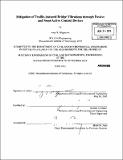Mitigation of traffic-induced bridge vibrations through passive and semi-active control devices
Author(s)
Magnuson, Amy R
DownloadFull printable version (4.716Mb)
Other Contributors
Massachusetts Institute of Technology. Dept. of Civil and Environmental Engineering.
Advisor
Jerome J.Connor.
Terms of use
Metadata
Show full item recordAbstract
Many of the U.S. bridges today are reaching or have reached their design life and are beginning to deteriorate and are becoming structurally deficient. Much time, effort, money, and resources go into repairing, rehabilitating, or reconstructing these bridges. Therefore, investigation into valid solutions to extending the safe life of these structures is of utmost importance. A major cause of bridge deterioration is stresses and fatigue induced in the bridge from traffic loading. This paper explores and investigates methods of mitigating traffic-induced bridge vibrations through the integration of control devices to extend the service life of bridges. There are three main classes of structural control devices: passive, semi-active, and active control. Each control scheme has advantages and disadvantages which are discussed in this thesis. To gain a better understanding of both passive and semi-active control strategies, a computer simulation is conducted. The computer simulation allows for a better comparison between passive and semi-active control schemes. The finding from the simulation shows a semi-active control strategy outperforming a passive strategy. The semi-active scheme reduces maximum midspan deflections by 20%, while the passive has a reduction of 12%.
Description
Thesis (M. Eng.)--Massachusetts Institute of Technology, Dept. of Civil and Environmental Engineering, 2011. Cataloged from PDF version of thesis. Includes bibliographical references (p. 51-52).
Date issued
2011Department
Massachusetts Institute of Technology. Department of Civil and Environmental EngineeringPublisher
Massachusetts Institute of Technology
Keywords
Civil and Environmental Engineering.